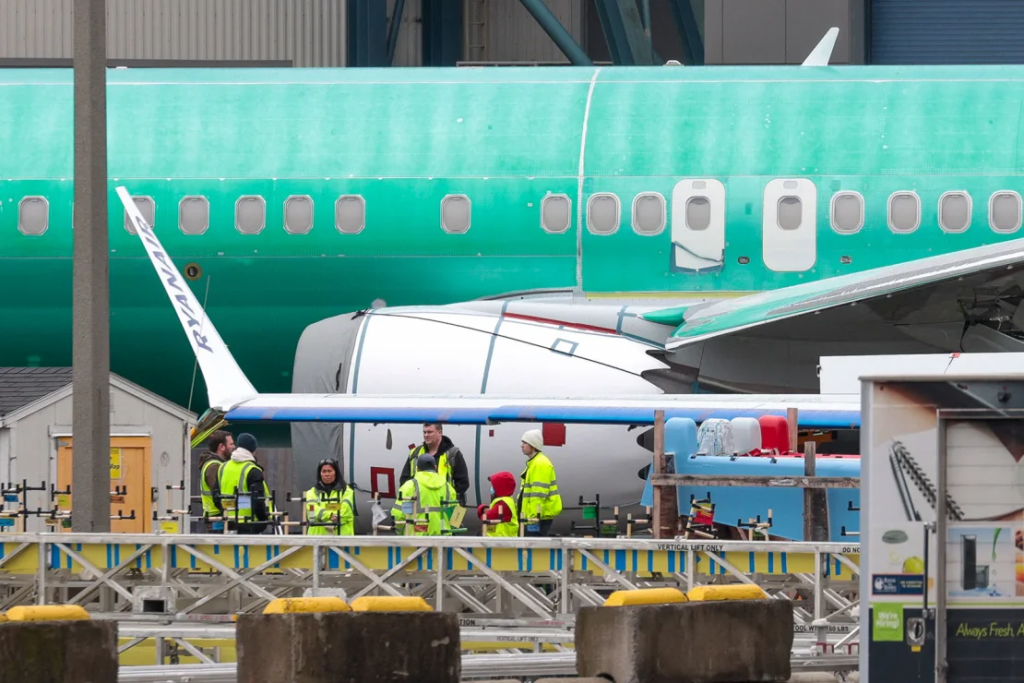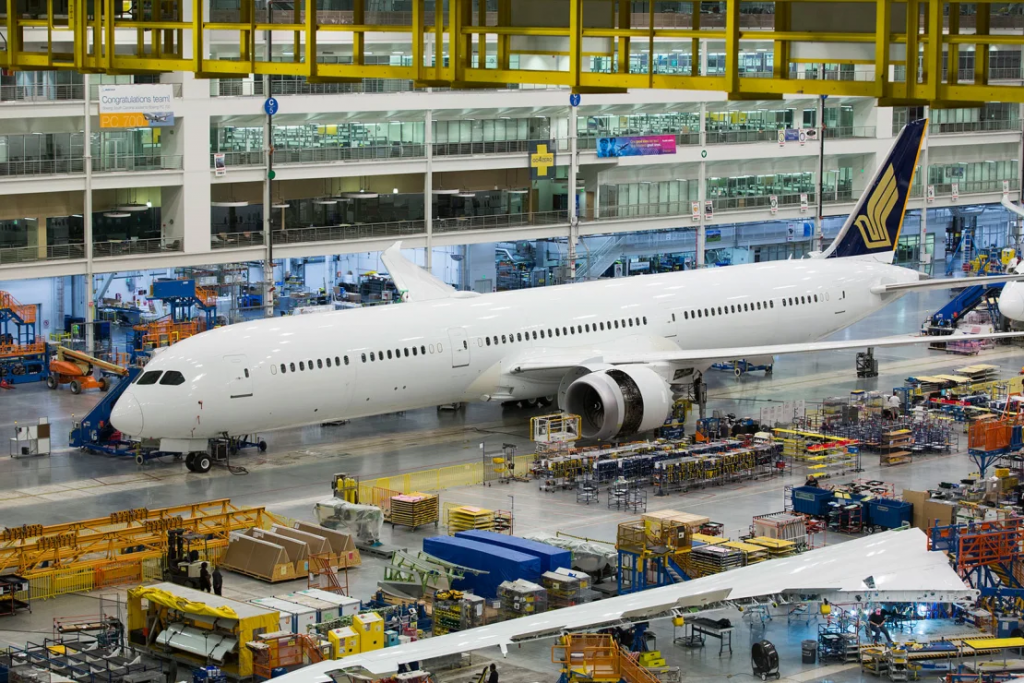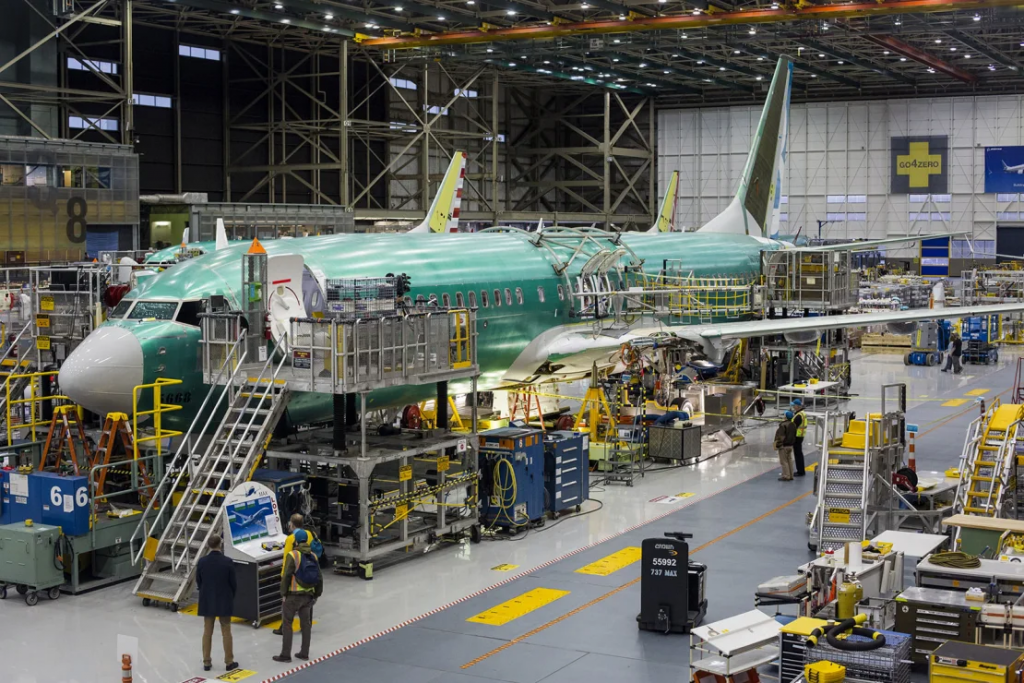New York – Part of the fuselage blowing off shortly after takeoff, leaving a gaping hole in the plane, and phones and clothing ripped away from terrified passengers. Investigations revealing sloppy work, including loose or missing bolts, instances of tools, trash and even empty tequila bottles left inside planes built for government clients. Worldwide groundings. Halts to deliveries due to quality issues.
And, by far, the most serious problem – two fatal crashes leaving 346 people dead.
Boeing is back in the headlines for all the wrong reasons again after the Alaska Airlines 737 Max 9 incident. The National Safety Transportation Board, which is investigating, is expected to release its preliminary findings soon.
That’s the Boeing of today and the last five years. But it wasn’t always that way.
It wasn’t that long ago that Boeing’s reputation was that of a staid industrial giant, known for building the safest, most advanced planes in the sky. It helped introduce the world to commercial jet travel.
Pilots and others in the industry, as well as members of the flying public, summed up their confidence in the company with the expression, “If it’s not Boeing, I’m not going.” The company still sells coffee cups and t-shirts with that slogan.
So how in the world did the company whose brand was once synonymous with safety become mired in reputational disaster – to the point where at least one travel site has a feature that allows passengers to avoid Boeing 737 Max planes altogether.
Experts and critics say that Boeing’s woes have been years in the making, some pointing to the result of a shift in corporate culture that started at the top and put profits ahead of the safety and engineering prowess for which it was once praised, placing not only its future, but the passengers on its planes, at grave risk.
While Boeing denies there has been such a shift away from safety and excellence, what is indisputable is that its engineering and manufacturing problems have contributed to a series of shocking incidents, two of which resulted in the deaths more than 300 people combined. Boeing simultaneously became a financial basket case, losing more than $26 billion, and counting, over the last five years, with no end to the red ink in sight.
Boeing executives insist that quality and safety are still a top priority for the company, and the problems of recent years have only increased its focus on quality and safety. Asked for comment on the claim that it now puts profits ahead of quality and safety, the company pointed to a recent statement by CEO Dave Calhoun.
“Over the last several years, we’ve added rigor around our quality processes, hired tens of thousands of engineers and mechanics, advanced key investments in our future, transformed our functions and gradually increased our production rates,” he told investors in October. “Most importantly, we’ve worked hard to instill a culture of speaking up and transparently bringing forward any issue, no matter the size, so we can get things right for the future.”
A week after Calhoun made the remark, the company delivered a 737 Max 9 to Alaska Air, the fourth it had built for the carrier that month. Code letters N704AL, the jet’s door plug blew out while the plane was mid-air, less than 10 weeks after it was delivered, just minutes into the January 5 flight.

Jason Redmond/AFP/Getty Images
The company also pointed to what it called a “quality stand down,” on Thursday for its 737 factory teams in Renton, Washington in which it halted production to focus on quality issues. Boeing announced the move in the wake of a recently expanded federal probe into the company’s manufacturing practices following the Alaska Air incident and plans for Congressional hearings into its practices.
The first 737 Max 9 planes that were grounded after that incident returned to service on Friday, and most are expected to be back in the air by the end of this week.
“Our long-term focus is on improving our quality so that we can regain the confidence of our customers, our regulator and the flying public. Frankly, we have disappointed and let them down,” said a statement by Stan Deal, the head of Boeing’s commercial airplane unit, in a statement to employees following that return to service. “Over the last century, the people of Boeing have faced and overcome significant challenges. This is one of those times. We have to be better. We have to deliver perfect airplanes each and every time.”
But critics say this crisis is unlike any earlier problems at the company, arguing that despite Boeing’s assurances, they believe there has been a cultural change within the company in the last 25 years that has put profits over safety and quality.
“Leadership is more concerned with getting the planes out the door than quality,” said Ed Pierson, a former Boeing executive who is now the executive director of the Foundation for Aviation Safety, a public interest group, told CNN last week. He said planes are still being produced today with flaws not being caught.
‘Everything had to be cost justified’
The spark for the conflagration that has recently consumed Boeing might date back decades.
After the Soviet Union collapsed in 1991, the huge American defense contractors began to consolidate. Fearful of their own survival without a communist enemy stalking NATO’s borders they began to merge with one another. In the decade after the end of the Cold War, 51 major American defense and aerospace contractors became just five huge companies.
And one of the five left standing was Boeing, newly merged in 1997 with competitor McDonell Douglas.
Critics said that before the merger, Boeing had a reputation as a company run by people with engineering backgrounds who cared about quality and safety first. But those critics say the merger put the company in the hands of executives with a finance background, who put profits as their top goal.
“Boeing had a reputation before the merger of a company where engineers were high church,” Ron Epstein, an aerospace analyst at Bank of America, told CNN. It resulted in Boeing not being as profitable as some comparable manufacturers, he said.
But after the merger he said, “everything had to be cost-justified.”
On paper, Boeing was the company that bought McDonnell Douglas. But many of the leadership ranks became filled with McDonnell Douglas veterans, not Boeing executives.
Many of them had financial backgrounds, not the engineering backgrounds of those who had run Boeing in the past. Or they came from outside of the company, such as from General Electric, where cost-cutting and improved efficiency was a near religion.
One of those was Jim McNerney, who became Boeing CEO in 2005, after a career that started at consumer products maker Procter & Gamble, included time at management consultant McKinsey & Co., and was followed by years at GE. He was CEO of 3M before being tapped to run Boeing, without any engineering and limited aerospace experience.

Aaron Schwartz/NURPHO/Associated Press
Moving away from its roots, saving cash
Under this leadership the company moved away, figuratively and literally, from its Pacific Northwest roots, where top executives had been intimately familiar with the massive assembly lines there where commercial jets were built, and any problems that might be developing there.
In 2001 it moved its headquarters to Chicago. And in the midst of various crises in recent years, it moved its headquarters again in 2022, not back to Seattle, but to a suburb of Washington, DC, near the Pentagon, Capitol Hill, and its various regulators, like the FAA. Ironically the move to Washington came the same week Airbus revealed that it was increasing production of commercial jets at its factory in Mobile, Alabama, only seeming to drive home the point to critics that Boeing was moving in the wrong direction.
“One company is saying ‘We’re going to build lots of jets.’ The other is saying ‘We’re going to lobby the Pentagon and Congress for defense dollars.’ It’s a big contrast,” said Richard Aboulafia, managing director at AeroDynamic Advisory and a leading aerospace analyst.
Boeing became more dependent on suppliers to build more and more of its planes, seeking to limit its role to joining together the parts. And it spun-off some of the operations it had depended upon previously. Supplier Spirit AeroSystems, which builds the fuselages for its Boeing’s planes, including the 737 Max, was created in 2005 after Boeing sold its Wichita division and Oklahoma operations raising $900 million in cash by doing so.
And in 2009, about a year after weathering a 58-day strike at its unionized plants in Washington state, the company announced plans for a non-union plant in right-to-work South Carolina to assemble its new, most advanced jet, the 787 Dreamliner, giving it a factory with lower pay that wasn’t at risk of going on strike in the future.

Joshua Drake Photography/Boeing
Calhoun, Boeing’s current CEO, took over in January 2020, nine months into the grounding of the 737 Max following two fatal crashes. He also has no engineering background, having served as senior managing director and head of portfolio operations at investing firm The Blackstone Group, CEO of Nielsen and spending 26 years at GE.
Just over a year and a half later, after the pandemic reduced demand for the long-range Dreamliner due to the drop in international travel, Calhoun and Boeing decided it needed to preserve cash and could no longer justify two 787 plants. It had a choice between consolidating production to a veteran plant in Washington state staffed by unionized employees and a non-union South Carolina plant. It decided to close the unionized line in Washington and keep the South Carolina plant.
But it soon had quality problems with the 787 Dreamliners being produced there, leading to two costly halts in deliveries, one lasting over a year.
Although Boeing says it values its worldwide staff, it made deep staff cuts during the economic downturn caused by the pandemic, offering buyouts to more senior workers. The loss of expertise has proven devastating, Bank of America’s Epstein said.
“A key variable is your workforce,” he said. “You want it to be as experienced as possible. When it’s all said and done, how much do you really save closing the unionized plant?”
Cost cutting’s impact on quality
Aviation safety advocate Pierson served as a senior manager at Boeing’s 737 factory after a career in the military. He left the company in 2018, just months before the first fatal crash. He told CNN his frustration with top management attitudes on quality forced him to quit.
In 2019 he testified to Congress that there was evidence that the 737 Max was having production quality issues, including planes being delivered to airlines that had faulty hardware or other system malfunctions, problems that involved more than a dozen safety issues, some of which he described as serious. He recounted that he had recommended a halt in production of the 737 Max to deal with quality issues in the months ahead of the first crash. He said the boss to whom he had made the recommendation told him, “We can’t do that, I can’t do that.”
“I pushed back, explaining that I had seen operations in the military shut down over less substantial safety issues, and those organizations had national security responsibilities,” he testified. He said his supervisor responded tersely, “The military isn’t a profit-making organization.”
Other experts agree with Pierson that despite its claims of being concerned with safety and quality, Boeing’s actions suggest otherwise.
“You’re looking at a management team whose idea of acknowledging the problem is to readjust the cash flow numbers for next year,” said Aboulafia in an interview with CNN.
Two fatal crashes
And then disaster struck.
The first fatal crash of a 737 Max occurred in Indonesia in October 2018, the second in Ethiopia in March 2019, killing a total of 346 people. It led to a 20-month grounding of all 737 Max jets. In addition to the horrifying loss of life, it cost the company more than $21 billion, making it one of the costliest corporate disasters on record, as well as one of the most deadly.
After the first crash, Boeing successfully pushed to keep the planes in the air. Even after the second crash, as airline regulators around the world grounded the jet, Boeing pushed the FAA to hold off on its own grounding order, saying that it had “full confidence in the safety of the 737 Max” and that “based on the information currently available, we do not have any basis to issue new guidance” to airlines.
When the FAA gave in to global and public pressure to announce its own grounding, Boeing said it accepted the move out of an “abundance of caution.”
Eventually it was a design flaw in the Max that was blamed for the two fatal crashes, as a feature meant to stop the planes from climbing too fast and stalling instead forced the nose of the planes downward.
But critics of Boeing say the problem wasn’t just the flawed design of the jet that led to the deaths, it was the decisions that Boeing made to not quickly acknowledge the problem with design after the first crash, and have a grounding take place at that time, which could have prevented the second crash.
“In the light most favorable to Boeing, the first crash was an accident, the second crash is a crime,” said Robert Clifford, the attorney suing Boeing on behalf of families of the victims of the second crash, the one in Ethiopia, in an interview with CNN. He said if the plane had been grounded immediately, Boeing might have ended up fixing the problem much faster, and with less expense, as well as preventing the second crash.
“They gambled with people’s lives and the people lost,” he said.
In 2021 Boeing admitted to liability in the two crashes, agreeing to pay compensatory damages, which allowed the company to avoid the possibility of having to pay far more in punitive damages.
“Boeing is committed to ensuring that all families who lost loved ones in the accidents are fully and fairly compensated for their loss,” the company said in a statement at that time. “By accepting responsibility, Boeing’s agreement with the families allows the parties to focus their efforts on determining the appropriate compensation for each family.”
It has also agreed to pay a $2.5 billion fine to settle charges it defrauded the FAA when it first won approval of the flawed 737 Max.
“I firmly believe that entering into this resolution is the right thing for us to do — a step that appropriately acknowledges how we fell short of our values and expectations,” Calhoun said at that time.
But that agreement was criticized by the families of victims of the Ethiopian air crash as well as members of Congress as being far too lenient. About 70% of the $2.5 billion fine it agreed to pay was money it had already agreed to pay as compensation to its airline customers.
Pierson said the probe that followed the second crash revealed Boeing executives were more concerned with continued production than finding the cause of the crash and fixing it.
“They absolutely prioritized the delivery of planes over the investigation,” he said.

David Ryder/Bloomberg via Getty Images/File
Pierson said the design flaw, as problematic as it was, was not the total problem that led to the crash. He said the quality of the work that would produce various malfunctions while the planes were in flight was just as significant as the design flaw.
He points to a report from the Ethiopian Aircraft Accident Investigation Bureau that looked at both fatal crashes and found that “These accidents were triggered by production quality defects that… presented as intermittent system malfunctions.”
Without the build quality issues causing malfunctions, the design flaw feature of the plane that forced the nose of the plane down would not have turned on, and the flights would not have crashed, according to the Ethiopian report.
But that finding got little attention as the US National Transportation Safety Board and the FAA focused on design flaws rather than the build quality issues, Pierson said.
Eventually the probe provided an ugly look at the decision-making process at Boeing. Internal communications released during the 737 Max grounding showed one employee describing the jet as “designed by clowns, who in turn are supervised by monkeys.”
Boeing’s release of the documents included an apology to the FAA, Congress, airlines, and the public.
The failed push for profits
An ironic part of Boeing’s focus on profits is that it has resulted in a company that is in the worst financial shape in its more than 100-year history, with five years of deep losses already, and more expected losses ahead.
As recently as 2018 Boeing was riding high, reporting revenue of more than $100 billion for the first time in its history and projecting more growth to come. It had just started deliveries of the 737 Max the year before. The short-term focus on profits was, indeed, producing profits. At least for a little while.
Its rival Airbus was the one struggling, on the verge of abandoning its $25 billion mistake, the A380 superjumbo jet that had turned out to be a white elephant with little demand from airlines or passengers. Despite that, the two companies were neck-and-neck in orders and deliveries.
But in less than a decade, all that has changed.
Airbus delivered 735 commercial jets last year. Boeing only 528. Net orders and the backlog of jets each is waiting to build show a larger imbalance. And while Airbus is forecast to report adjusted net income of $4.3 billion euros, or $4.7 billion profit, for 2023 when it reports results, Boeing is forecast to report a loss of $3.6 billion next week.
Aboulafia said the short-sighted push for profits has put the company at a severe competitive disadvantage to Airbus, and that Calhoun and other top managers at Boeing, as well as its board, need to go if the company is to have a chance to turn things around.
Despite the losses and severely weakened market position of Boeing, there is little chance it could go out of business.
The airlines around the world that have already bought Boeing planes basically need to keep using those models, whatever the problems.
Commercial pilots are certified on specific models and are not able to easily move from single-aisle to widebody versions of Boeing jets, let alone between a Boeing and an Airbus jet. And having different models means the airlines need to have a large, expensive supply of spare parts on hand to keep their planes in the air.
And any Boeing customer who canceled their orders today would have to get in line behind a backlog of more than 8,600 jets that Airbus has already agreed to build for its existing customers.
“It’s a very weird industry. It has high barriers to entry and only two players. You can get away with nonsense like this,” said Aboulafia.
Pierson said incident reports on planes that Boeing continues to build, while not nearly as dramatic as the Alaska Air incident, suggest the pressure to put profits over quality remains, despite Boeing’s claims.
“The company has gutted quality control so they can produce more airplanes,” he said. “The employees are completely overwhelmed. Everybody is focused on the Max 9, and rightfully so. That incident should never have happened. But there are issues on other planes. It has become a recipe for disaster.”
As reported by CNN
